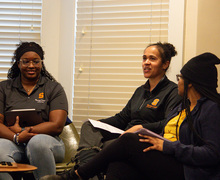SU, SUNY ESF students attend March to End Fossil Fuels alongside community organizations
Courtesy of Chet Guenther
Approximately 90 Syracuse University and SUNY ESF students as well as community organizers joined about 75,000 total protesters in New York City.
Get the latest Syracuse news delivered right to your inbox.
Subscribe to our newsletter here.
When Izzy Kaufman began her high school job at a restaurant, she immediately noticed the amount of food waste it produced.
Kaufman, now a sophomore at Syracuse University studying environmental sustainability and policy and international relations, decided to implement change by starting a program for local farms to pick up leftover food. She pointed to this experience as a key reason why she attended the March to End Fossil Fuels in New York this weekend, seeing the impact of taking initiative toward addressing environmental issues.
“I think the best thing you could do is start small because truly, we have to change our lifestyles to accommodate the state of the environment, and that’s what we do, is one little step at a time,” Kaufman said.
Kaufman was one of approximately 90 students and community organizers from the Syracuse area who attended the protest Sunday, joining about 75,000 total protesters as they marched through Manhattan to the United Nations building.
The march, organized by several New York grassroots organizations, called for President Joe Biden to declare a climate emergency and an end to the use of fossil fuels. SU and SUNY ESF students who attended, along with local community activists, said the march instilled a sense of solidarity and inspiration for action.
“Everyone was kind of on the same page, and everyone should have the same passion for sustainability and ending fossil fuels in that area,” said Kaufman, who also currently serves as the co-chair of sustainability for SU’s Student Association. “It was so exciting from that standpoint, to be around like-minded people.”
The New York Public Interest Research Group organized a cohort of students to travel from Syracuse to New York City. Chet Guenther, a program director for NYPIRG, said organizing the group showed him the potential students have to influence change, despite sometimes being dismissed by older politicians.
“Something that really matters to young people is the climate crisis and making sure that we are addressing the issues that come with using fossil fuels to make sure that we have a world that we can live on, in years to come,” Guenther said. “It was very important that students were given a presence.”
Guenther said that seeing students and other protesters from different areas and walks of life at the march gave him hope for the future of mitigating the “existential threat” of climate change.
“I am very hopeful, and I think that everyone should take hope and solace in what this march symbolizes, but not lose track of the idea that we are in a climate crisis,” Guenther said.
The march came before the U.N.’s Climate Action Summit, a meeting of global governmental and economic leaders to present and discuss policy actions to address climate change, on Wednesday.
The march specifically highlighted the impact of climate change on Black and Indigenous communities who have historically borne the brunt of climate change. Makiyah Lazore, a sophomore at ESF and member of the Onondaga Nation in the Haudenosaunee Confederacy, said she marched at the front of the protest with other Indigenous protesters.

The march, organized by several New York grassroots organizations, called for President Joe Biden to declare a climate emergency and an end to the use of fossil fuels.
Troy Conner | Contributing Photographer
Lazore, who has participated in other local environmental education programs through the Center for Native Peoples and the Environment at ESF, is now planning to create a club at ESF to educate other students about the environment in her culture.
“In my culture, we plan ahead for the next seven generations, and so it’s really important for me, as a youth, to continue what my elders have done and also just by continuing like culture and keeping indigenous voices out there because like they have been silenced for so long,” Lazore said.
As a lifelong resident of the Syracuse region, Lazore said she and her community have seen the effects of climate change firsthand in central New York. This summer, Lazore was unable to perform land surveys as part of her internship in Tully, a town south of Syracuse, because wildfire smoke, unpredictable weather patterns and temperatures have affected traditional ceremonies, she said.
“The main reason why I stepped out and started doing stuff with climate change was because it really was affecting my culture and our growing seasons and our ceremonies as well as our water pollution,” Lazore said. “Obviously, we can’t go fishing out on Onondaga Lake, and that’s a really big tradition for the Native American culture.”
Andy Mager, another longtime Syracuse resident and community organizer who attended the march, said he’s noticed weather changes in the area that have impacted his gardening. He’s changed planting seasons because of warming temperatures.
Mager, who is the coordinator of the Syracuse Cultural Workers and a member of the Syracuse Peace Council, has been involved in environmental sustainability advocacy and other community work for over 40 years. He said bringing in the help of young people brings a new energy to the movement.
“I recognize that we need to continue to encourage and support new generations of activists and organizers, and also to recognize that young people bring their own sort of perspective and ideas to this work,” Mager said.
Mager said it was inspiring for him to see the commitment of students at the march, as he was a student protester himself.
“Sometimes as a young person, these things can feel completely daunting, but recognizing that you’re part of this historic tradition, and as a young person really welcomed into that tradition and into the organizations and spaces to find your voice to add your contributions to the next, I think is a very empowering and important experience,” Mager said.
Many march participants showed their energy through drumming, singing, chanting and holding signs, Kaufman said. Messages at the march included signs saying “Biden, our future’s on fire,” and chants like “Exxon Mobil, BP, Shell, take your sh*t and go to hell,” she said.
“It was like you could actually feel the energy in the crowd. You feel the passion, you could feel everyone’s determination to make this big change that we’ve been fighting for for so long and will continue to fight for it for so long,” Kaufman said.
While Kaufman agreed that it was inspiring, Lazore said the march had a solemn undertone of urgency.
“In some ways, it made me glad that I was able to be there, but also, it’s sad that we had to be there,” Lazore said. “In the moment, (it) feels so empowering. But then when you take a step back and look at it, it’s like, we really shouldn’t be in this situation.”
Published on September 20, 2023 at 11:16 pm
Contact Stephanie: spwright@syr.edu





